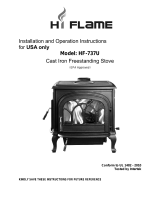
Page 2 / VG650ELG MOUNTAINEER™ VGZ-025 / 100105.0
9. Be sure that your chimney is safely constructed
and in good repair. Have the chimney inspected
by the fire department or a qualified inspector.
Your insurance company should be able to rec-
ommend a qualified inspector.
10. Creosote or soot may build up in the chimney
connector and chimney and cause a house/
building fire. Inspect the chimney connector
and chimney twice monthly during the heat-
ing season and clean if necessary. (See Chim-
ney Maintenance, page 12).
11. In the event of a chimney fire, turn the air con-
trol to closed position, leave the building and
CALL THE FIRE DEPARTMENT IMME-
DIATELY! Have a clearly understood plan on
how to handle a chimney fire by contacting
your local fire authority for information on
proper procedures in the event of a chimney
fire.
12. To prevent injury, do not allow anyone to use
this stove who is unfamiliar with the correct
operation of the stove.
13. Do not operate stove while under the
influence of drugs or alcohol.
14. Ashes should not be allowed to accumulate
above sides of ash drawer. Dispose of ashes in
a metal container with a tight fitting lid. Keep
the closed container on a noncombustible floor
or on the ground, well away from all combus-
tible materials. Keep the ashes in the closed
container until all cinders have thoroughly
cooled. The ashes may be buried in the ground
or picked up by a refuse collector.
15. The special paints used on your stove may
give off some smoke and an odor while
they are curing during the first 12 to 15 fires.
Additional smoke and odor may be emitted
from the light oils used in construction of the
fire box. This should disappear after a short
period of time and not occur again. Persons
with lung conditions or owners of susceptible
domestic pets (such as birds) should take
prudent precautions. Open windows and doors
as needed to clear smoke and/or odor. Paint
discoloration will occur if the stove is
overfired.
16. This stove has a painted surface which
is durable but it will not stand rough handling
or abuse. When installing your stove, use care
in handling. Clean with soap and warm water
when stove is NOT hot. Do not use any acids
SAFETY INSTRUCTIONS continued…
or scouring soap, as these solvents wear and
dull the finish.
17. While stove is in operation, all persons,
especially young children should be alerted to
the hazards from high surface temperatures.
Keep away from a hot stove to avoid burns or
clothing ignition.
18. The walls of the firebox may become slightly
distorted after a period of use. A slight distor-
tion will not affect the operation of the stove.
19. If small children will be in the same room as
the stove during operation, provide a sturdy
barrier to keep them at a save distance
from the stove. NEVER LEAVE SMALL
CHILDREN UNSUPERVISED when they
are in the same room as the stove.
20. Keep stove area clear and free from all
combustible materials, gasoline, and other
flammable vapors and liquids.
21. To prevent burns always wear protective
clothing, leather hearth gloves and eye
protection, while tending the fire.
22. While in operation, keep the feed door closed
and secured at all times except while tending
the fire.
23. Do not overfire the stove. Overfiring will
occur if the feed door or ash clean-out cover
are left open during operation. Such actions can
result in very dangerous operating conditions.
24. DO NOT ELEVATE FIRE! Build fire directly
on the bottom of the firebox. This stove has
not been tested with the use of grates, andirons,
or other means of elevating fire and should not
be used.
25. All power cords and electrical appliances
and/or assemblies must be kept outside of the
clearance dimensions shown in this manual for
combustible materials.
26. For further information on using your stove
safely, obtain a copy of the National Fire
Protection Association (NFPA) publication,
“Using Coal and Wood Stoves Safely” NFPA
No. HS-10-1978. The address of the NFPA is
Batterymarch Park, Quincy, MA 02269.
NOTE: A PROFESSIONAL, LICENSED HEATING
AND COOLING CONTRACTOR MUST
BE CONSULTED IF YOU HAVE QUESTIONS
REGARDING THE INSTALLATION OF THIS
SOLID FUEL BURNING APPLIANCE.


























